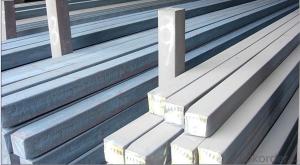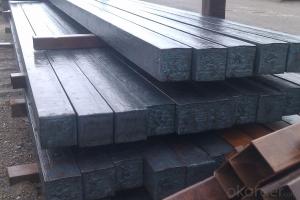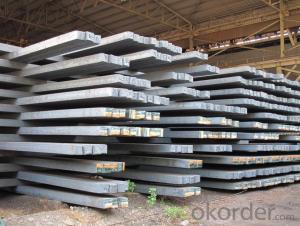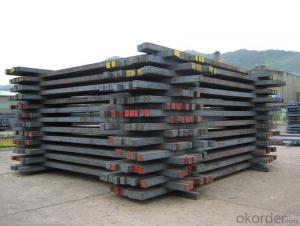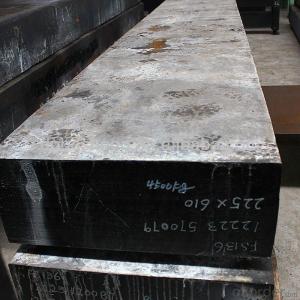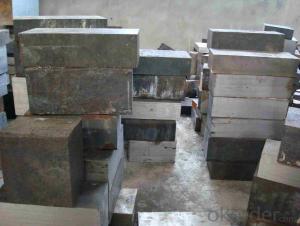Prime square alloy steel billet 130mm Q235
- Loading Port:
- Shanghai
- Payment Terms:
- TT OR LC
- Min Order Qty:
- 100 m.t.
- Supply Capability:
- 10000 m.t./month
OKorder Service Pledge
OKorder Financial Service
You Might Also Like
Structure of Prime square alloy steel billet 130mm Q235

Description of Prime square alloy steel billet 130mm Q235
Manufacture Progress:HRC-CRC-GALVANIZED-COLOR COATED
Application : Construction, electrical, transportation, steel plant, composite board plant, steel tile factory
Payment & Shipping Terms:T/T ,L/C, and FOB CHINA
Minimum Order Quantity: 25Tons
Packge Type: Moisture-proof paper inner,Steel outside,Bundle by steel rope.
Package in Container : Wood as a foot pad, wire rope reinforcement,PPGI steel coil tied together by steel rope.

Main Feature of Prime square alloy steel billet 130mm Q235
Uncoated CR steel sheet
With the features of in line with the international highest standards in demension and shape, excellent surface finish and properties, the products are mainly used in home appliance and automobile industries.
Galvanized steel sheet(include HDG and EG)
With the features of good corrosion resistance, the products are mainly used in automobile, home appliance, electronics, building and machinery manufacture industries, etc.
Precoated steel sheet
With the features of enviromental protection and good processablility, long lasting surface durability, rich in colors, the products are maily used in building, home appliance and furniture industries, etc.
Applications of Prime square alloy steel billet 130mm Q235
1) Excellent corrosion resistance: The zinc layer provides a good protection of Pre-painted Galvanizeed Steel Sheet.
2) High heat resistance: The reflective surface of the material aids in efficiently reflecting the sunlight away and in turn reducing the amount of heat transmitted. The thermal reflectivity converts into energy savings.
3) Aesthetics: Pre-Painted Galvanized steel sheet is available in plethora of patterns and multiple sizes as per the requirements that given by our customers.
4) Versatility: can be used in the various areas.

Specifications of Prime square alloy steel billet 130mm Q235
Product | Billet |
Material Grade | SGCC / SGCH / DX51D+AZ, etc |
Thickness | 0.6-3.0mm |
Width | 500-1500mm |
Tolerance | Thickness: +/-0.02mm , Width:+/-2mm |
Zinc-coating | Z30-150g/m2 |
Technique | Raw material: Hot rolled steel coil --> Cold rolled_>hot dipped galvalume |
Surface | Dried, Chromated, Unoiled |
Spangle | Regular spangle , small spangle, zero spangle |
ID | 508MM 610MM |
Coil weight | 1-25MT |
Export package | Cardboard inner sleeves, Waterproof paper, galvanized steel covered and steel strip packed |
FAQ of Prime square alloy steel billet 130mm Q235
We have organized several common questions for our clients,may help you sincerely:
1. How Can I Visit There?
Our company is located in Tianjin City, China, near Beijing. You can fly to Tianjin Airport Directly. All our clients, from home or aboard, are warmly welcome to visit us!
2. How Can I Get Some Sample?
We are honored to offer you sample.
3. Why choose CNBM?
we always fix steel produce in container well to make it safe arrive at destination port
we always provide best and professional forward service for our buyer
we always apply 14days free detention for our buyers container in destination
we provide one set After-sales service for our buyer
we provide China inland steel market price report
we help our buyer become number one in local market .
- Q:How do steel billets compare to other forms of raw steel material?
- Steel billets possess unique advantages when compared to other forms of steel. Their exceptional strength and durability are well-known. They are manufactured using a meticulously controlled process that ensures uniform composition and consistent grain structure, resulting in superior mechanical properties. Consequently, steel billets are highly suitable for industries requiring robust and dependable steel, such as construction, automotive, and manufacturing. Additionally, steel billets offer remarkable machinability. Their uniform shape and size facilitate easy handling and processing, thereby reducing waste and improving production efficiency. This proves especially advantageous for manufacturers utilizing precision machining techniques to create intricate and complex components. Another benefit of steel billets lies in their versatility. They can be forged, rolled, or extruded into various shapes and sizes, allowing for customization according to specific requirements. This adaptability renders steel billets suitable for an extensive range of applications, ranging from structural beams and bars to pipes and rods. Moreover, steel billets boast a relatively low carbon content, making them more ductile compared to other forms of raw steel material. This enhanced ductility enables simpler shaping and forming, making steel billets particularly appropriate for hot working processes like forging and rolling. In summary, steel billets offer numerous advantages over other forms of raw steel material. Their high strength, excellent machinability, versatility, and ductility make them the preferred choice for many industries. Whether it is for structural purposes or the manufacturing of complex components, steel billets possess the necessary properties and flexibility to meet a wide range of requirements.
- Q:What are the different machining processes for steel billets?
- There are several machining processes that can be used for steel billets, depending on the desired outcome. Some common machining processes for steel billets include turning, milling, drilling, and grinding. Turning involves rotating the billet against a cutting tool to remove material and create a desired shape. Milling involves using a rotating cutter to remove material from the billet, typically in a perpendicular or angled direction. Drilling involves creating holes in the billet using a drill bit. Grinding involves using an abrasive wheel to remove material and create a smooth surface finish on the billet. These machining processes can be combined or used individually to achieve the desired shape, dimensions, and surface finish for the steel billet.
- Q:How are steel billets used in the manufacturing of tools?
- The production of tools relies on the use of steel billets, which serve as the starting material. Steel billets are semi-finished products that have a square or rectangular shape and are made of solid steel. They are created through a process called steelmaking, which involves melting iron ore to produce steel. To manufacture tools, the steel billets undergo a preliminary step of heating to a specific temperature known as the forging temperature. At this temperature, the steel becomes flexible and can be easily shaped. The billets are then shaped using various forging techniques, including hammering, pressing, or rolling, until they take on the desired form of the tool. Once the billets have been forged into the desired shape, they undergo further processing through machining operations. These operations, such as milling, drilling, grinding, or turning, are used to achieve the required dimensions and surface finish. Excess material is removed during this stage, and the tool's shape and features are refined. After the machining process, the tools undergo heat treatment to enhance their mechanical properties. This involves subjecting the tools to specific heating and cooling cycles, which alter their hardness, toughness, and resistance to wear. This step is crucial in ensuring that the tools can withstand the demanding conditions they will encounter during use. Finally, the tools are given a finishing touch and coating to provide protection against corrosion and improve their appearance. This can involve processes such as sandblasting, polishing, and the application of protective coatings like chrome plating or powder coating. In conclusion, steel billets play a vital role in the manufacturing of tools, serving as the raw material that undergoes forging, machining, heat treatment, and finishing. The properties of the steel billets, such as their composition and metallurgical characteristics, contribute significantly to the final quality, strength, and durability of the tools produced.
- Q:How are the surface defects of steel billets repaired?
- The surface defects of steel billets are repaired through a process called grinding or machining. This involves removing the defective areas by using specialized tools and techniques to smoothen out the surface and make it suitable for further processing or use in various industries.
- Q:How are steel billets used in the manufacturing of power plant equipment?
- Steel billets are used in the manufacturing of power plant equipment as they serve as the raw material for various components such as turbine blades, shafts, and boiler tubes. These billets are shaped and machined to form the specific parts needed for power generation, ensuring strength, durability, and high-performance capabilities in the harsh operating conditions of power plants.
- Q:How do steel billets contribute to the renewable energy sector?
- The renewable energy sector heavily relies on steel billets for the production of different renewable energy technologies. Wind turbines, for example, require the use of steel billets to construct their towers and foundations. These structures need to be sturdy and durable to withstand harsh environmental conditions. Additionally, steel billets are crucial in the manufacturing of solar panels. These panels are composed of photovoltaic cells that convert sunlight into electricity. Steel billets are used to create frames and mounting structures that provide support and stability to the solar panels, ensuring their proper functioning and long lifespan. Moreover, steel billets are essential in the production of hydroelectric power equipment. Hydroelectric power is generated by converting the kinetic energy of flowing or falling water into electricity. Steel billets are ideal for constructing turbine blades, shafts, and other components due to their high strength and resistance to corrosion, enabling the efficient generation of electricity from water. Furthermore, steel billets play a vital role in the manufacturing of energy storage systems, such as batteries. Since renewable energy sources like wind and solar are not consistently available, energy storage systems help store excess energy during peak times for later use. Steel billets are used in the construction of battery casings and structural components, ensuring the safety and durability of these storage systems. To sum up, steel billets are indispensable in the renewable energy sector as they provide the necessary raw material for the construction of wind turbines, solar panels, hydroelectric power equipment, and energy storage systems. Their strength, durability, and corrosion resistance make them a critical element in producing various renewable energy technologies, ultimately contributing to the acceleration of a sustainable and greener future.
- Q:How are steel billets recycled or reused?
- Various methods can be employed to recycle or reuse steel billets, which are semi-finished metal products. One commonly used method is electric arc furnace (EAF) steelmaking, where the billets are melted down in an electric arc furnace and utilized in the production of new steel products. This process effectively utilizes resources and aids in the reduction of greenhouse gas emissions and energy consumption compared to primary steel production. Steel billets can also be repurposed in industries like construction, automotive, and manufacturing. They can be transformed and reconfigured to create novel steel products or utilized as raw material for forging, rolling, or extrusion processes. By reusing steel billets, the industry can alleviate the demand for newly manufactured steel and conserve natural resources. Moreover, steel billets can be recycled through continuous casting. In this technique, the molten steel is poured into a continuous casting machine, resulting in the formation of solid billets. These billets can then undergo hot or cold rolling processes to produce various steel products such as bars, rods, or wire. Furthermore, steel billets can be melted and recast into different forms via remelting. Technologies like induction melting or vacuum arc remelting can be employed to purify the steel and achieve desired chemical and mechanical properties. Remelting facilitates the production of high-quality steel billets suitable for specialized applications in industries such as aerospace, defense, or medical sectors. In conclusion, steel billets are effectively recycled or reused through processes like electric arc furnace steelmaking, continuous casting, remelting, and reshaping. These methods not only contribute to the sustainability of the steel industry but also aid in resource conservation, emission reduction, and meeting the rising demand for steel products.
- Q:What is the maximum length of a steel billet?
- The maximum length of a steel billet can vary depending on various factors such as the production process, equipment capabilities, and industry standards. However, in general, steel billets are commonly produced with lengths ranging from a few meters to around 12 meters.
- Q:How are steel billets used in the production of aerospace structures?
- Steel billets are an essential component in the production of aerospace structures. These billets are typically made from high-quality steel and serve as the starting material for various aerospace components. They are used in forging, which is a manufacturing process that involves shaping the metal by applying compressive forces. Aerospace structures, such as aircraft frames, wing spars, landing gear components, and engine parts, require materials with exceptional strength, durability, and resistance to fatigue. Steel billets provide these qualities, making them ideal for the aerospace industry. The production of aerospace structures begins with the selection of the appropriate steel billets. These billets are carefully inspected to ensure they meet the required specifications and quality standards. Once approved, they undergo a series of processes, including heating, forging, and machining, to transform them into the desired shape and size. During the forging process, the steel billets are heated to a specific temperature and then subjected to intense pressure, either through hammering or pressing. This force causes the billets to deform and take the shape of the aerospace component being manufactured. The precise control of temperature and pressure ensures that the resulting structure has the desired mechanical properties and meets the stringent safety requirements of the aerospace industry. After forging, the aerospace structures are further machined and finished to achieve the necessary dimensional accuracy and surface quality. This may involve cutting, drilling, milling, and grinding processes. The steel billets' ability to withstand these machining operations without compromising their structural integrity is crucial in producing aerospace structures that meet the stringent performance standards. In summary, steel billets play a vital role in the production of aerospace structures by providing the necessary strength, durability, and fatigue resistance. Through forging and subsequent machining processes, these billets are transformed into various components, ensuring the structural integrity and safety of aerospace systems. The utilization of high-quality steel billets guarantees that the resulting structures meet the demanding requirements of the aerospace industry.
- Q:What are the main safety considerations when handling steel billets?
- The main safety considerations when handling steel billets include wearing appropriate personal protective equipment such as gloves, safety glasses, and steel-toed boots to protect against potential injuries. Proper lifting techniques should be used to prevent strains and back injuries when moving heavy billets. Additionally, ensuring a well-organized and clutter-free work area, as well as proper storage and stacking of the billets, can help prevent accidents and injuries.
1. Manufacturer Overview |
|
|---|---|
| Location | |
| Year Established | |
| Annual Output Value | |
| Main Markets | |
| Company Certifications | |
2. Manufacturer Certificates |
|
|---|---|
| a) Certification Name | |
| Range | |
| Reference | |
| Validity Period | |
3. Manufacturer Capability |
|
|---|---|
| a)Trade Capacity | |
| Nearest Port | |
| Export Percentage | |
| No.of Employees in Trade Department | |
| Language Spoken: | |
| b)Factory Information | |
| Factory Size: | |
| No. of Production Lines | |
| Contract Manufacturing | |
| Product Price Range | |
Send your message to us
Prime square alloy steel billet 130mm Q235
- Loading Port:
- Shanghai
- Payment Terms:
- TT OR LC
- Min Order Qty:
- 100 m.t.
- Supply Capability:
- 10000 m.t./month
OKorder Service Pledge
OKorder Financial Service
Similar products
New products
Hot products
Hot Searches
Related keywords
